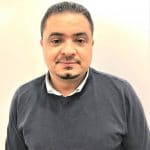- Project in progress
- CEA-SI-2020-002
On course to 6G telecommunications

Rafik ZAYANI
« I have been in academic research settings my whole career. I wanted to see the more practical side of research, working on topics directly applicable to industrial use cases. The CEA is the ideal place to do that. »
With much lower latency and power consumption than 5G, 6G will enable a whole new generation of services. Given what is ahead, it comes as no surprise that researchers are intent on exploring the potential of new technologies like massive MIMO.
Rafik Zayani answered the Science Impulse call for projects on “energy-efficient systems for 6G communications,” which he will spend the next three years investigating at CEA-Leti. Zayani will collaborate closely with the CEA-Leti scientists and engineers already hard at work overcoming the challenges to 6G transceiver design and optimization. Wireless communications could soon be responsible for 14% of global carbon emissions. The research Zayani will be contributing to comes with a very ambitious target of reducing 6G energy consumption by 90%. His experience in the field is clearly a plus.
Networks past, present, and future
The first generation (1G) of mobile telecommunications technology, which appeared in the 1980s, was analog. If you are too young to remember those early shoebox-sized mobile phones personally, you have probably seen them in movies or on TV. The size of these prehistoric devices seems almost comical today. Just imagine how long it took for a call to go through!
This technology was soon replaced by the first all-digital mobile communications technology: 2G. The move from analog to digital made 2G much, much faster than 1G—but only fast enough for voice communications and short text messages. The transmission rates of this 2G technology were severely limited by bandwidth.
3G marked another step forward, with the introduction of a new broadband coding technology that increased the theoretical transmission rate. The faster speeds were a revolution for users, who could now send full-color messages and even videos—albeit not in real time.
The wide frequency bands used for 4G communications enhanced the user experience even more, enabling smooth web browsing, real-time video, and a host of other services. 4G—now available almost everywhere—has fundamentally changed the way people use their mobile devices. The result of this democratization is a data deluge. Despite efforts to develop more frugal components and software, digital services will continue to consume more and more energy as 5G is rolled out. The culprits: a sharp increase in the number of IoT devices and the emergence of new services that need more computing capacity—computing that is done by energy-hungry components.
Bringing energy consumption down
The Science Impulse energy-efficient 6G challenge is ambitious. The goal is to reduce energy consumption by 90% for the same (or better) quality of service. The number of IoT devices in service is growing rapidly. The next standard will not only have to continue to satisfy consumers’ appetites for higher transmission speeds and new services, it will also need to meet the more demanding requirements of the healthcare, farming, transportation, manufacturing, and other industries.
Zayani will focus on the physical layer, on components—major culprits when it comes to energy consumption. The latest transmission techniques (multicarrier waveforms and massive MIMO) generate high-dynamic signals that require a chain of hefty radiofrequency components. To provide the necessary transmission quality, these components have to transmit the signal without distorting it and without negatively impacting performance.
Zayani and his colleagues at CEA-Leti are tackling the problem from a novel angle, investigating how to leverage low-cost, low-to-average-quality, compact components to deliver quality transmission affordably and efficiently. They will be using existing low-power components with proven performance. One drawback that the researchers will have to overcome is these components’ tendency to distort the signal to the detriment of transmission quality. And the lower the quality of the components used, the more the signal is distorted. The digital components of wireless communications systems are already low-power. The radiofrequency components, on the other hand, account for 90% of total system energy consumption. This is where the low-cost components will come in. The researchers will develop new algorithms on the digital side to correct hardware-induced signal distortion for analog-to-digital converters, digital-to-analog converters, and power amplifiers.
CEA-Leti has been working on these technologies for years. Measurement data from radiofrequency modules and signal processing algorithms will be used to build new radiofrequency module models. The CEA’s wireless transmission program will contribute its expertise in signal processing algorithms, while the systems department will support the RF module design aspects of the research. This know-how will provide Zayani with valuable insights on potential integration scenarios and energy savings.
In practical terms, Zayani will be able to leverage the CEA’s existing resources to test different combinations of converters and algorithms to advance the state of the art and arrive at a viable low-power system that will meet telecommunications operators’ needs.
MIMO, a promising new technology
When a single antenna is used to transmit a signal wirelessly, energy radiates in all directions, with only a small portion reaching the receiving antenna. The rest is “lost” in the environment. Plus, only one user can be served by a given frequency at a given time, further limiting network capacity.
Introduced with 4G networks, massive MIMO (for multiple-input, multiple-output), uses arrays of multiple small antennas controlled in a coordinated manner rather than a single antenna. When multiple transmitting antennas are used, the signal can be focused on a particular point. This prevents the losses seen with single-antenna architectures. It also enables multiple users to be served by the same frequency simultaneously. This increases transmission speed and creates additional network capacity. MIMO is standard for 5G (3GPP Release 15), but is still very costly to implement. Huge, energy-hungry (five-ton, 100-watt) mobile communications towers are needed to cope with increasing numbers of antennas and the associated RF transmission chains.
A revolutionary approach called virtual massive MIMO consists of using several access points that share the antennas on the towers. These access points would be built using the low-cost, low-power components mentioned above. Access points would be smaller and have fewer antennas, making MIMO a good candidate for faster, less expensive network rollout. This kind of virtual massive MIMO offers the added benefit of being easy to implement for industry 4.0 use cases and to create dedicated networks in natural disaster scenarios, for instance.
A hundred antennas could be used to serve ten users (instead of just one with previous solutions). This provides a lot of latitude to correct hardware-induced signal distortion. The solution being investigated in this research for 6G works like this: The radiofrequency signal is duplexed and reflected off objects and focused onto the receiver by the electronics, improving performance. This work also aligns nicely with other CEA research on reconfigurable reflective surfaces.
About Rafik Zayani
After earning a degree from the National Engineering School of Tunis (ENIT) in 2003, Zayani went on to earn a Masters in Telecommunications in 2004. He obtained his PhD in 2009, joining the faculty at ISI Tunis and conducting research at Innov’COM, a laboratory of Sup’Com Tunis. In 2020 he was accredited to supervise research by CNAM (Conservatoire National des Arts et Métiers) in Paris, France.
As an associate member of CNAM, Zayani has initiated a number of projects with the institution, contributing to research on energy-efficient power amplification for multicarrier waveform-based solutions. In 2015, as part of the French National Research Agency WONG5 project, which included the study of new waveforms, Zayani crossed paths with Thales and the CEA.
In 2018, he won a European Commission MSCA (Marie Skłodowska-Curie Actions) Individual Fellowship to support researchers’ careers by providing opportunities abroad and to stimulate excellence in research. In 2020, Zayani applied for the Science Impulse fellowship.
His interest in applied research is not new. Zayani has always been keen to work within the practical constraints of implementing technology in real-world use cases. Industrial R&D projects also provide an opportunity to learn new skills that Zayani deems crucial to his work, which spans academic research, industrial R&D, and project management.
Zayani followed the path of his father, a mechanical engineer, when he decided to pursue an engineering degree at ENIT. It was then that he first became interested in telecommunications. At the time (in 2000), the field was in its infancy, offering exciting opportunities to break new ground.
Writing/Translation : Sara FREITAS – Christophe JARDIN




